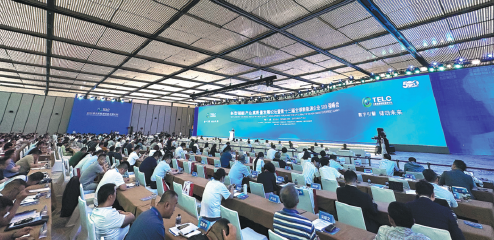Energy revolution garners global attention
Updated: 2023-09-15

Representatives from 40 countries share their insights into the latest developments of the energy industry at the 2023 Taiyuan Energy Low Carbon Development Forum. [Photo by Li Zhaomin for China Daily]
Thousands of people attend sustainable development forum in the city of Taiyuan
Shanxi's energy revolution campaign and sustainable growth once again garnered great attention from the international community as nearly 5,800 representatives from 40 countries attended a forum in Taiyuan, the capital city of this North China province last week.
The event, the 2023 Taiyuan Energy Low Carbon Development Forum, ran from Sept 6 to 8. Centering around the theme of "smart energy for a green and win-win future", the event consisted of a summit forum, four international conferences, 11 parallel symposiums and two sub-events featuring Shanxi's development in the energy industry and presenting investment opportunities.
The landmark achievements of the forum included eight memorandums of understanding and agreements of intent for forging or deepening ties between cities in Shanxi and the rest of the world; the release of a white paper on digitalized energy development and 18 other documents; and the signing of agreements among enterprises.
According to the forum's organizers, Shanxi's enterprises, development zones and local governments at the city or county level had signed agreements with businesses from China and across the world on 52 investment projects with pledged investments totaling 62.06 billion yuan ($8.52 billion).
The forum was the highest-profile and largest-scale international event held in Shanxi this year and was also an important international event in China's energy industry.
Lan Fo'an, secretary of the Shanxi Provincial Committee of the Communist Party of China, introduced the latest development of Shanxi's energy revolution campaign at the event's opening ceremony.
He said that Shanxi is a flagship province in China's energy revolution strategy. The local campaign is aimed at promoting an energy industry transformation toward the direction of cleaner and more efficient operations, ensuring national energy supply, safeguarding national energy safety and contributing solutions to global climate change.
China's solutions to global warming, of which Shanxi's practices in energy revolution are an important part, were praised by a number of foreign dignitaries attending the forum. They included Teuea Toatu, vice-president of Kiribati; Korn Dabbaransi, former deputy prime minister of Thailand and current president of the Thai-Chinese Friendship Association; and Horace Chang, deputy prime minister and minister of national security of Jamaica. They also expressed their intentions to work with China on improving the global energy governance system.
Experts and industry insiders at the forum shared their insights into the latest developments of the energy industry and proposed suggestions to promote sustainable growth.
At one symposium, Zhang Guobin, an expert and official from the National Forestry and Grassland Administration, highlighted the importance of carbon sinks in helping China with its goals of reaching peak carbon and carbon neutrality.
Carbon sink is a technical term that refers to anything that absorbs more carbon from the atmosphere than it releases — for example, plants, the ocean and soil.
"Stabilizing the reserves of forests, grasslands and wetlands is the most crucial part of China's plans for peak carbon and neutrality," Zhang said. "This requires new zoning and utilizing new management models for our land resources."
He also talked about the role of China's carbon trade in helping to improve carbon sink capacity.
China launched a nationwide carbon trading system in December 2017, in an effort to establish a national carbon market that ranks among the world's biggest.
Under the scheme, the demand side – mostly in the energy and emission-intensive industries – is assigned emission quotas and those producing more than their share of emissions are allowed to buy unused quotas on the market from those engaged in developing carbon sink capacities, or even those that cause less pollution. On the other hand, the supply side reaps economic benefits through selling quotas.
This practice can motivate enterprises to reduce their emissions to lower their costs and suppliers to enhance their carbon sink capacity, according to Zhang.
Shanxi's officials and business representatives also shared their best-practice cases in assisting low-carbon development.
One practice is the promotion of digital and intelligent technologies to upgrade coal mines toward the direction of cleaner and more efficient operations.
An official attending the forum said that Shanxi is now home to 46 intelligent coal mines and 1,161 intelligent mining shafts, which means that more than 80 percent of the province's coal output is from these advanced facilities.
Shanxi is also accelerating development in new and clean energy sectors such as solar and wind power, hydrogen and coal-bed methane.
Latest statistics show that the installed capacity of power generation facilities using new energy resources reached 54.62 million kilowatts, accounting for 43 percent of Shanxi's total.
At the forum, Zheng Peng, chairman and president of Pengfei Group, talked about the booming development of the hydrogen industry at his company and in the Shanxi city of Lyuliang, where the company is based.
Zheng said his company used to be a major coal producer in Lyuliang, with its current coal output still standing at about 30 million metric tons a year.
The company has diversified its business over recent years, with operations now covering such sectors as coking; production of methanol, liquefied natural gas, synthetic ammonia and hydrogen; logistics and cultural tourism.
"We are currently one of the leading hydrogen producers in Lyuliang, with an annual capacity of 20,000 tons of high-purity hydrogen," Zheng said.
But that capacity is only the beginning of a planned superlarge industry cluster by Pengfei. "We are investing about 78 billion yuan in developing a hydrogen industry park, which is expected to generate an annual output worth 180 billion yuan when it is fully operational," said Zheng.
He noted that this gigantic facility features recycled resources and the utilization of clean energy.
"In the facility, the hydrogen will be generated from coking gas," Zheng said. "And the electricity supply will be from our own solar and wind farms."
Pengfei's hydrogen industry chain, which includes 100-plus hydrogen-filling stations and a plant that can assemble 300,000 hydrogen fuel cell heavy-duty trucks every year, is to create more than 35,000 jobs.
The city of Lyuliang is a hydrogen industry hub in Shanxi, ranking first in terms of output in recent years. It is also a pioneer in the development of hydrogen in China as a new source of energy.
During the United Nations climate change conference, known as COP27, held in Sharm el-Sheikh, Egypt, on Nov 14, 2022, the practices by Lyuliang in hydrogen energy development were shared as a case study among participants.
He Kai and Zhang Yi contributed to this story.



